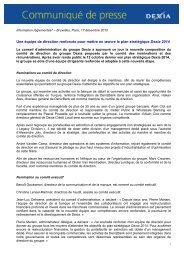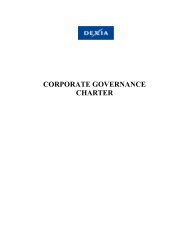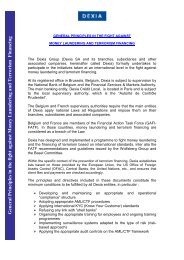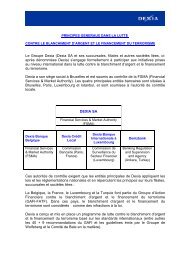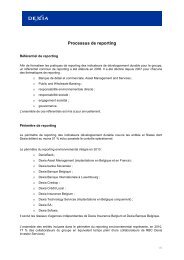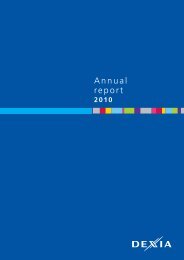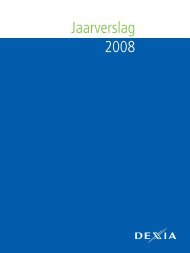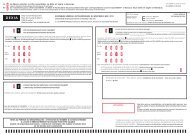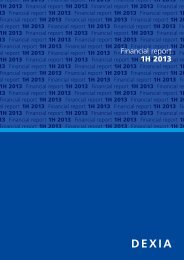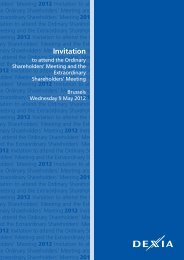Annual report 2009 - Dexia.com
Annual report 2009 - Dexia.com
Annual report 2009 - Dexia.com
- No tags were found...
Create successful ePaper yourself
Turn your PDF publications into a flip-book with our unique Google optimized e-Paper software.
Notes to the consolidated fi nancial statementsManagement <strong>report</strong>Consolidatedfinancial statements<strong>Annual</strong> financial statementsAdditional informationAll purchases and sales of trading securities that require deliverywithin the time frame established by regulation or marketconvention (“regular way” purchases and sales) are recognisedat trade date. Other trading transactions are treated asderivatives until settlement occurs (see also Paragraph 1.6.“Trade date and settlement date accounting”).1.15.2. Liabilities held for tradingLiabilities held for trading follow the same accounting rulesas those for loans and securities held for trading.1.15.3. Loans and securities measured at fairvalue through profit or lossLoans and securities designated at fair value through statementof in<strong>com</strong>e follow the same accounting rules as thosefor loans and securities held for trading.Under the fair value option, a financial asset, a financial liabilityor a group of financial instruments can be designatedby the entity as “at fair value through profit or loss”, providedthat doing so results in more relevant information orincreases measurement reliability. The fair value option simplifiesthe application of IAS 39. It is used:• when such designation eliminates or significantly reducesa measurement or recognition inconsistency that wouldotherwise arise;• when a group of financial assets, financial liabilities or bothis managed and its performance is evaluated on a fair valuebasis, in accordance with a documented risk management orinvestment strategy;• when an instrument contains a non-closely related embeddedderivative.The use of the fair value option is an accounting policy choicewhich should be made for the entire financial instrument, atinitial recognition and when certain conditions of documentationare fulfilled.1.15.4. Liabilities measured at fair value throughprofit or lossThe above <strong>com</strong>ments on the fair value option are also validfor the liabilities.1.16. Loans and securities available for saleand securities held to maturityManagement determines the appropriate classification of itsinvestments at initial recognition. However, under certain conditions,financial assets could be subsequently reclassified.Quoted securities with fixed maturity are classified as held-tomaturity(HTM) when management has both the intent andthe ability to hold the assets to maturity.Securities and loans and receivables intended to be held foran indefinite period of time, which may be sold in responseto needs for liquidity or changes in interest rates, exchangerates or equity prices, are classified as available for sale(AFS).Securities and loans and receivables are initially recognised atfair value plus transaction costs. Interest is recognised basedon the effective interest-rate method and is recognised withinnet interest in<strong>com</strong>e.Available-for-sale financial assets are subsequently remeasuredat fair value based on quoted bid prices and/or bid pricesderived from available market spreads or amounts derivedfrom internal valuation models in case of inactive markets.Unrealised gains and losses arising from changes in the fairvalue of financial assets classified as available for sale are recognisedwithin equity. When securities are disposed of, therelated accumulated fair value adjustments are included inthe statement of in<strong>com</strong>e as “Net in<strong>com</strong>e on investments”.Held-to-maturity investments are carried at amortised costusing the effective interest method, less any allowance forimpairment.1.17. DerivativesDerivative financial instruments generally include foreignexchange contracts, currency and interest-rate futures, forwardrate agreements, currency and interest-rate swaps andcurrency and interest-rate options (both written and purchased).All derivatives are initially recognised in the balancesheet at fair value and are subsequently remeasuredat fair value. Fair values are obtained from quoted marketprices, discounted cash flow models or pricing models asappropriate.Derivatives are <strong>report</strong>ed as assets when fair value is positiveand as liabilities when fair value is negative.The amount <strong>report</strong>ed on these lines of the balance sheetincludes the premium paid/received net of amortization, therevaluation to fair value and the accrued interest. The sumof all these elements is representing the dirty fair value ofthe derivative.Certain derivatives embedded in other financial instruments,are treated as separate derivatives when:• their risks and characteristics are not closely related to thoseof the host contract; and• the hybrid contract is not carried at fair value with unrealisedgains and losses <strong>report</strong>ed in the statement of in<strong>com</strong>e.1.18. Hedging derivativesOn the date a derivative contract is entered into, <strong>Dexia</strong> maydesignate certain derivatives as either:(1) a hedge of the fair value of a recognised asset or liabilityor a firm <strong>com</strong>mitment (fair value hedge); or(2) a hedge of a future cash flow attributable to a recognisedasset or liability or a forecasted transaction (cash flowhedge); or(3) a hedge of a net investment in a foreign entity (net investmenthedge).If a derivative is not designated in a hedging relationship, it isto be deemed held for trading or part of a fair value optionstrategy.Hedge accounting may be used for derivatives designated inthis way, provided certain criteria are met.The criteria for a derivative instrument to be accounted for asa hedge include inter alia:• formal documentation of the hedging instrument, hedgeditem, hedging objective, strategy and relationship preparedbefore hedge accounting is applied;• the hedge is documented showing that it is expected to behighly effective (within a range of 80% to 125%) in offsettingchanges in fair value or cash flows attributable to the114<strong>Dexia</strong> <strong>Annual</strong> <strong>report</strong> <strong>2009</strong>



